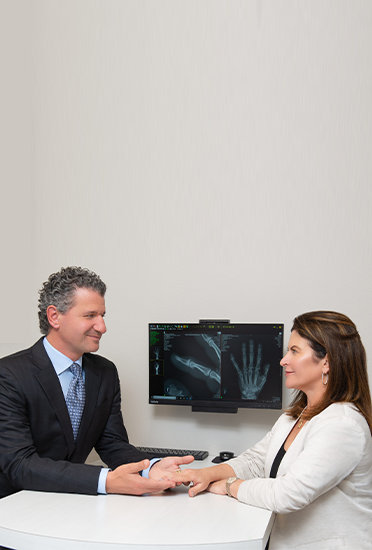Wrist Joint Replacement

Wrist joint replacement surgery involves the substitution of a faulty wrist joint with an artificial one crafted using metal and polyethylene (plastic). This prosthesis is designed to resemble a healthy wrist in terms of function. The medical term for this joint replacement is arthroplasty.
Your wrist joint, also known as your radiocarpal joint, is an intricate assembly of tiny bones. It mediates between your forearm and hand – from elbow to digits.
Your wrist joint is crucial to your wrist movement, allowing you to bend, straighten and rotate it easily. The simple actions such as gesturing hello or waving goodbye are just the beginning: typing on a keyboard, washing your hair – even picking up something off the floor – all depend upon this small joint. Daily tasks can become extremely painful if it’s damaged in any way or becomes stiff from lack of use.
If you want to consult a doctor for your wrist problems – contact Sforzo | Dillingham | Stewart Orthopedics + Sports Medicine to arrange an appointment with our highly skilled medical professionals. We specialize in diagnosing and treating muscular and skeletal medical issues.
Wrist Joint Replacement – Why Is It Needed?
When cartilage is worn or damaged by age, trauma, illness, or infection over time, the bones rub against each other. As a result, they progress to a degenerative state. The result is unbearable pain as both ends of the bone wear away – known as arthritis.
- Osteoarthritis – Osteoarthritis, the most frequent form of arthritis, is a consequence of the erosion and breakdown of cartilage that covers bones due to aging and years of use.

- Rheumatoid Arthritis – Rheumatoid Arthritis is a relentless inflammatory disorder that brings aches, rigidity, and inflammation to its victims. The autoimmune condition typically manifests in multiple joints on both sides. Invariably, it is caused when the body’s natural defense mechanism mistakenly targets healthy tissue instead of foreign invaders.
- Post-Traumatic Arthritis – Post Traumatic arthritis is a type of joint inflammation that can be linked to trauma or injury. While similar in many ways to osteoarthritis, posttraumatic arthritis usually occurs suddenly and has an identifiable cause, like a fractured bone caused by an accident.
Wrist Joint Replacement – Who Is The Right Candidate?
The ideal candidate for wrist joint replacement surgery is someone who has experienced the debilitating effects of arthritis but does not require frequent use of their wrists in everyday tasks. Ultimately, this procedure can offer individuals relief from pain and help to maintain the strength of both the hand and wrist.
Current wrist joint replacement implants are not as resilient as hip or knee implants. Therefore these models are unsuitable for those with an active lifestyle that involves lifting heavy weights or excessive stress placed on the wrists during day-to-day activities. They work most efficiently in people who have a relatively low amount of strain put onto their hands daily.
Wrist fusion surgery may be the optimal solution for those seeking to remain active and exert significant force with their wrists. Not only does this procedure remove motion at the wrist joint, but it will also leave you feeling pain-free while providing your body with enough strength to manage heavier demands.
The Procedure of Wrist Joint Replacement

Wrist joint replacement is a procedure that can be done on an outpatient basis, so you don’t have to stay in the hospital overnight. Even better, this surgery may also work with other treatments or techniques to correct disorders and deformities related to your fingertips and thumb tendons, nerves, and joints.
To perform the procedure:
- The surgeon opens the back of the wrist with a precise cut.
- The surgeon eliminates the arthritic edges of the lower arm bones and may even remove the first row of carpal bones.
- The surgeon then places the prosthesis’ radial part within the center of the radius bone on the lower arm’s thumb side. This section will generally be secured with specialized adhesive cement.
- Based on the component design, a surgeon can place the carpal component into either the center hand bone (third metacarpal) or affix it to other rows of carpal bones with screws. Bone cement may guarantee stability; some carpals could be linked or fused.
- The surgeon precisely places a spacer of the correct size between the metallic components.
- After the procedure, the skin is meticulously sutured to close it. A splint may be added for extra support to ensure proper healing.

Benefits of Wrist Joint Replacement
Here are the advantages that wrist joint replacement surgery offers:
- Improve your range of motion in your wrist for greater flexibility.
- Enhance the functionality of your wrist, hand, and arm with greater ease.
- Enjoy a reduction in wrist pain and stiffness.
- Relief from the painful wrist joint.
Risks of Wrist Joint Replacement
Despite being uncommon, wrist replacement surgery may lead to certain complications. These include:
- The onset of infection in your joint following the surgery.
- The wound may become infected.
- The prosthesis can suffer from malfunctioning, such as breaking, loosening, or becoming dislocated.
- Another possibility is nerve injury.
Wrist Joint Replacement – Recovery

A splint or cast must be worn in the first few weeks following surgery. Although immediate pain relief is expected, physical therapy should still be done over several weeks to improve mobility and strength. As you progress in your rehabilitation program, increased power and endurance will also become possible.
The physical requirements imposed on a wrist prosthesis will drastically reduce its lifespan. Therefore, it is important to be aware of the possible restrictions, such as:
- Hammering or utilizing pneumatic tools should be avoided.
- To ensure injury prevention, monitor how much weight you are lifting.
- It’s best to abstain from activities that might lead to a fall to keep your prosthetic wrist from sustaining damage. Just like with natural wrists, falls on an outstretched arm could cause breaks in the prosthesis.
While wrist prostheses have advanced greatly, implants may become loose or malfunction due to wear and tear. In such instances, further surgery will be required to maintain the implant’s functionality.
Conclusion
Those suffering from severe wrist arthritis can find relief through wrist replacement surgery. It eliminates pain and restores most of the joint’s movement, allowing individuals to enjoy everyday activities. The new implant typically lasts up to fifteen years or more; however, patients must avoid strenuous activity and fall on outstretched hands after the operation to protect the success of their procedure.
Contact us at Sforzo | Dillingham | Stewart Orthopedics + Sports Medicine if you need a consultation. Our team is dedicated to helping those suffering from wrist issues, spine injuries, and sports-related traumas. So give us a call at 941.378.5100 today for an appointment.

























